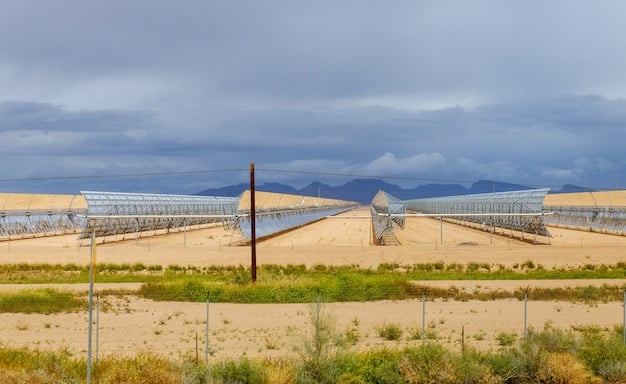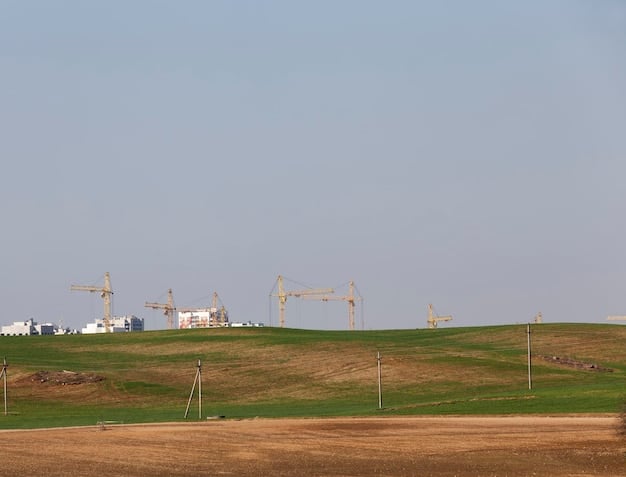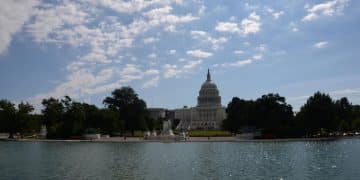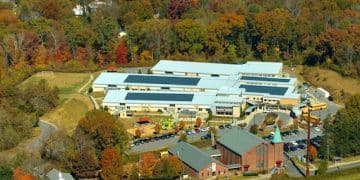US Energy Policy: Investing in Renewables for a Sustainable Future

The US energy policy shift involves a significant move towards renewable energy sources, aiming for a sustainable future by reducing reliance on fossil fuels and mitigating climate change through investments in solar, wind, and other green technologies.
The US energy policy shift: investing in renewable energy sources for a sustainable future marks a pivotal moment as the nation transitions away from traditional fossil fuels. This transformation is driven by growing concerns about climate change, energy security, and the economic opportunities presented by green technologies. Understanding the nuances of this policy shift is crucial for anyone interested in the future of energy in the United States.
Understanding the US Energy Policy Shift
The US energy policy is undergoing a significant overhaul. This shift is motivated by a complex interplay of environmental concerns, economic opportunities, and geopolitical factors. The move towards renewable energy is not just a trend, but a strategic realignment of national priorities.
This policy shift aims to foster a more sustainable and resilient energy infrastructure. By investing in renewable sources, the US hopes to reduce its carbon footprint and create a cleaner, healthier environment for future generations.

Key Drivers of the Renewable Energy Transition
Several factors are driving the transition to renewable energy in the US. These include technological advancements, decreasing costs, and increasing public awareness of climate change. Government policies and incentives also play a crucial role.
Understanding these key drivers is essential for grasping the full scope of the energy policy shift and its potential impact on the US economy and environment.
Technological Advancements
Rapid advancements in renewable energy technologies, such as solar photovoltaics and wind power, have made these sources more efficient and cost-effective.
Decreasing Costs
The cost of renewable energy has plummeted in recent years, making it increasingly competitive with traditional fossil fuels. This cost reduction is a major catalyst for the energy transition.
- Solar energy costs have decreased by over 80% in the last decade.
- Wind energy is now one of the cheapest sources of electricity in many parts of the US.
- Battery storage technologies are also becoming more affordable, enhancing the reliability of renewable energy.
The convergence of these factors is accelerating the deployment of renewable energy across the country.
Federal Policies and Renewable Energy Investment
Federal policies play a vital role in shaping the direction of renewable energy investment in the US. Key policies include tax incentives, renewable energy standards, and research and development funding.
These policies are designed to encourage the development and deployment of renewable energy technologies, as well as to create a level playing field for renewable energy in the energy market.

Tax Incentives
Tax incentives, such as the Investment Tax Credit (ITC) and the Production Tax Credit (PTC), provide financial incentives for renewable energy projects.
Renewable Energy Standards
Renewable energy standards (RES) require utilities to generate a certain percentage of their electricity from renewable sources.
- Many states have adopted RES, driving the growth of renewable energy at the state level.
- These standards create a stable market for renewable energy and encourage investment in new projects.
- The federal government also provides funding for research and development in renewable energy technologies.
These policies collectively contribute to a supportive environment for renewable energy investment in the US.
State-Level Initiatives Driving Renewable Growth
While federal policies set the overall framework, state-level initiatives are crucial for driving the growth of renewable energy. States like California, New York, and Massachusetts have implemented ambitious renewable energy targets and policies.
These initiatives include feed-in tariffs, net metering programs, and state-level tax incentives.
California’s Renewable Energy Leadership
California has long been a leader in renewable energy, with a goal of 100% clean energy by 2045.
New York’s Green New Deal
New York’s Green New Deal sets ambitious targets for renewable energy and energy efficiency.
- Massachusetts has implemented policies to support offshore wind development.
- These state-level initiatives are accelerating the transition to renewable energy across the US.
- They also serve as models for other states looking to promote renewable energy.
The combination of federal and state policies is creating a powerful momentum for renewable energy growth in the US.
Economic Benefits of Investing in Renewable Energy
Investing in renewable energy offers significant economic benefits, including job creation, economic development, and energy independence. The renewable energy industry is a growing sector of the US economy, providing new opportunities for workers and businesses.
Moreover, renewable energy can reduce the US’s reliance on foreign energy sources, enhancing national security and energy independence.
Job Creation
The renewable energy industry is a major source of job creation, employing millions of people across the US.
Economic Development
Renewable energy projects can bring economic development to rural areas and create new opportunities for local communities.
- Energy independence is a key benefit of investing in renewable energy.
- Renewable energy can reduce the US’s reliance on foreign energy sources.
- This enhances national security and reduces the risk of energy price volatility.
The economic benefits of renewable energy extend beyond job creation and economic development, contributing to a more stable and resilient economy.
Challenges and Obstacles to Renewable Energy Adoption
Despite the many benefits of renewable energy, there are also challenges and obstacles to its widespread adoption. These include grid integration issues, intermittency concerns, and regulatory barriers.
Addressing these challenges is crucial for ensuring a smooth and successful transition to a renewable energy future.
Grid Integration
Integrating renewable energy into the existing electricity grid can be complex, requiring upgrades to transmission infrastructure and grid management systems.
Intermittency
Renewable energy sources like solar and wind are intermittent, meaning they are not always available when needed. This requires the development of energy storage solutions and flexible grid management strategies.
- Regulatory barriers can also hinder the development of renewable energy projects.
- Streamlining the permitting process and reducing regulatory uncertainty are essential for promoting renewable energy investment.
- Addressing these challenges requires a concerted effort from policymakers, industry stakeholders, and researchers.
Overcoming these obstacles is essential for realizing the full potential of renewable energy in the US.
The Future of Renewable Energy in the US
The future of renewable energy in the US looks promising, with continued growth and innovation expected in the coming years. As costs continue to decline and technologies advance, renewable energy is poised to become an increasingly dominant source of electricity.
The US is well-positioned to become a global leader in renewable energy, driving economic growth and creating a more sustainable future.
Continued Growth
The renewable energy industry is expected to continue growing rapidly in the coming years, driven by policy support, technological advancements, and decreasing costs.
Innovation
Continued innovation in renewable energy technologies, such as advanced solar panels, wind turbines, and energy storage systems, will further enhance the competitiveness of renewable energy.
- The US has the potential to become a global leader in renewable energy.
- By investing in renewable energy, the US can drive economic growth and create a more sustainable future.
- The transition to renewable energy is not just an environmental imperative, but also an economic opportunity.
The US can lead the way in developing and deploying renewable energy technologies, creating new jobs and industries in the process.
| Key Point | Brief Description |
|---|---|
| ☀️ Renewable Energy Growth | US is increasing investments and capacity in solar, wind, and other renewable sources. |
| 🌱 Environmental Benefits | Transitioning to renewables helps reduce carbon emissions and protect the environment. |
| 💼 Economic Opportunities | Renewable energy investments lead to job creation and economic development. |
| ⚡Policy Support | Federal and state policies incentivize renewable energy projects and adoption. |
FAQ
▼
The shift is driven by concerns about climate change, energy security, decreasing renewable energy costs, and technological advancements, making renewables a viable alternative to fossil fuels.
▼
Key policies include tax incentives like the Investment Tax Credit (ITC) and Production Tax Credit (PTC), renewable energy standards, and research and development funding initiatives.
▼
States implement renewable energy targets, feed-in tariffs, net metering programs, and tax incentives, fostering local renewable energy development and serving as models for other regions.
▼
Investing in renewables leads to job creation in manufacturing, installation, and maintenance, stimulates economic development in rural areas, and enhances energy independence, reducing reliance on foreign sources.
▼
Challenges include integrating intermittent renewable sources into the grid, upgrading transmission infrastructure, addressing energy storage needs, and streamlining regulatory processes to facilitate project development efficiently.
Conclusion
The **US energy policy shift: investing in renewable energy sources for a sustainable future** represents a fundamental transformation in the nation’s energy landscape. While challenges remain, the economic and environmental benefits of renewable energy are undeniable, paving the way for a cleaner, more sustainable future for the United States.





